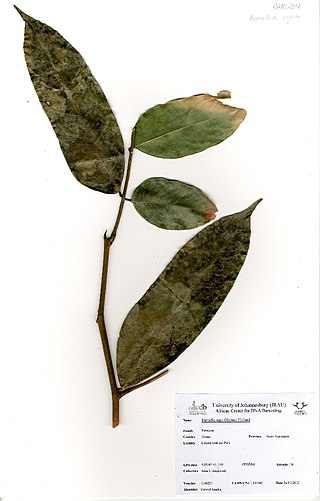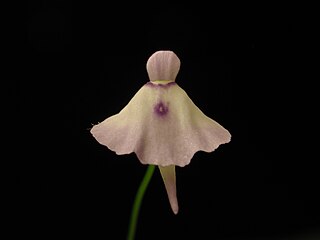
Afzelia is a genus of plants in family Fabaceae. The thirteen species all are trees, native to tropical Africa or Asia.

Cynometra is genus of tropical forest trees with a pantropical distribution.

The subfamily Detarioideae is one of the subdivisions of the plant family Fabaceae (legumes). This subfamily includes many tropical trees, some of which are used for timber or have ecological importance. The subfamily consists of 84 genera, most of which are native to Africa and Asia. Pride of Burma and tamarind are two of the most notable species in Detarioideae. It has the following clade-based definition:
The most inclusive crown clade containing Goniorrhachis marginataTaub. and Aphanocalyx cynometroidesOliv., but not Cercis canadensisL., Duparquetia orchidaceaBaill., or Bobgunnia fistuloides(Harms) J. H. Kirkbr. & Wiersema.

Anthonotha is a genus within the subfamily Detarioideae of the plant family Fabaceae.

Berlinia is a genus of flowering plants in the family Fabaceae. It includes 21 species of trees native to sub-Saharan Africa, ranging from Guinea to Chad, Tanzania, Mozambique, and Angola.

Cryptosepalum is a genus of flowering plants in the family Fabaceae. There are 12 species, mostly trees. They are native to sub-Saharan Africa, ranging from Guinea to Tanzania, Mozambique, and Angola.

Daniellia is a genus of plants in the family Fabaceae, named after William Freeman Daniell. It includes ten species native to sub-Saharan Africa, ranging from Senegal to Sudan and south to Zambia and Angola.
Englerodendron is a small genus of legumes belonging to the family Fabaceae, that are native to tropical Africa.

Gilbertiodendron is a genus of legume in the family Fabaceae. It consists of about 25 species of tree native to west and west-central tropical Africa. Members of this genus were formerly considered to be in the genus Macrolobium but that genus is now restricted to species growing in tropical America. It is closely related to Pellegriniodendron.
Plagiosiphon is a genus of plants in the family Fabaceae. It includes five species of trees or shrubs native to west and west-central Africa. They grow in tropical lowland Guineo-Congolian rain forest, often along rivers, on rocky banks, or on hillsides. Four species are limited to Cameroon, Gabon, and Republic of the Congo in west-central Africa. Plagiosiphon emarginatus also grows in Guinea, Sierra Leone, Liberia, and Côte d'Ivoire in West Africa.
Talbotiella is a genus of flowering plants in the family Fabaceae. It includes 9 species native to west-central and west tropical Africa. Most species ranges from Ghana to the Republic of the Congo. Five are endemic to Cameroon. T. cheekii is endemic to Guinea.

Newtonia is a genus of flowering plants in the legume family, Fabaceae. It includes 16 species of trees native to sub-Saharan Africa. It belongs to subfamily Caesalpinioideae and the Mimosoid clade or tribe. The genus is known from the early Miocene of Ethiopia based on compressions of its diagnostic, winged seeds.

Utricularia pubescens is a small to medium-sized, probably annual, terrestrial or lithophytic carnivorous plant that belongs to the genus Utricularia and is the only member of Utricularia sect. Lloydia. U. pubescens is native to India, tropical Africa, and Central and South America. It was originally published and described by James Edward Smith in 1819 and placed in its own section, Lloydia, by Peter Taylor in 1986. It grows as a terrestrial or lithophytic plant in boggy grasslands in damp peaty soils at altitudes from sea level to 1,900 m (6,234 ft). This species possesses small peltate leaves, which are diagnostic for this species in the genus.
Stachyothyrsus is a genus of flowering plants in the legume family, Fabaceae. It belongs to the subfamily Caesalpinioideae. It includes two species native to tropical Africa.
Aphanocalyx is a genus of flowering plants in the family Fabaceae. It belongs to the subfamily Detarioideae. It includes 14 species native to tropical Africa, ranging from Sierra Leone to Côte d'Ivoire, and from Cameroon to Angola and Tanzania.
Pseudoprosopis is a genus of flowering plants in the family Fabaceae. It includes seven species of shrubs, lianas, or small trees native to tropical Africa. Typical habitats include tropical rain forest, gallery forest, seasonally-dry forest, and dense thicket. Three species are native to west-central Africa, two species to West Africa, and two species to southeastern Africa – one to the Zambezian region and one to the Zanzibar–Inhambane region. The genus belongs to the mimosoid clade of subfamily Caesalpinioideae.

Prioria is a genus of flowering plants in the family Fabaceae. Members of this genus are found in Central America, Africa, southern Asia, and Oceania.

Micklethwaitia is a monotypic genus of legume in the family Fabaceae. Its only species, Micklethwaitia carvalhoi, is endemic to Mozambique. It is closely related to Annea, Gabonius, and Scorodophloeus.
Aubrevillea is a genus of flowering plants in the family Fabaceae. It belongs to the mimosoid clade of the subfamily Caesalpinioideae. It includes two species of trees native to west and central Africa, ranging from Senegal to Democratic Republic of the Congo.












